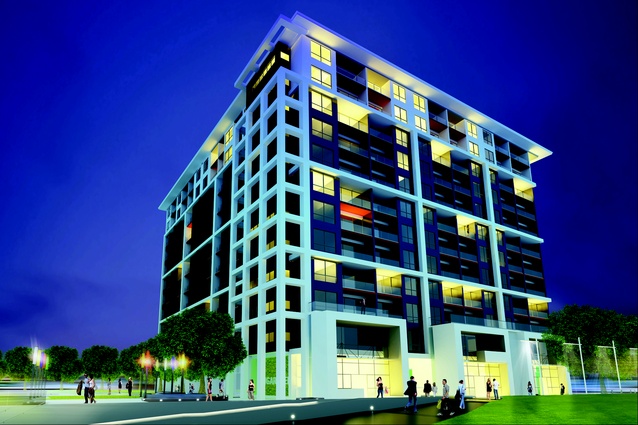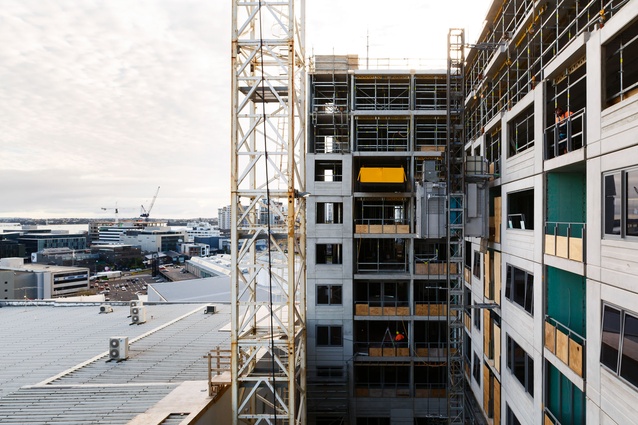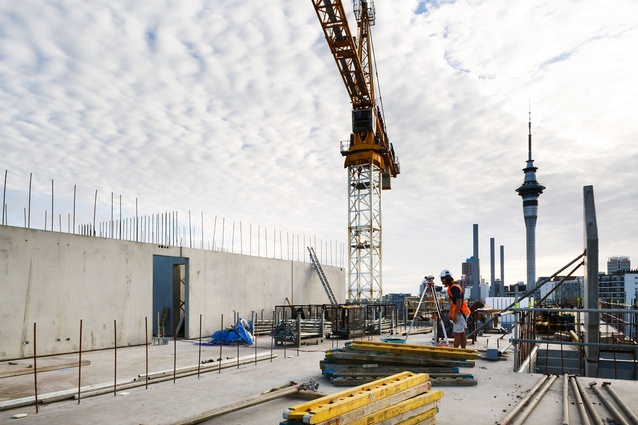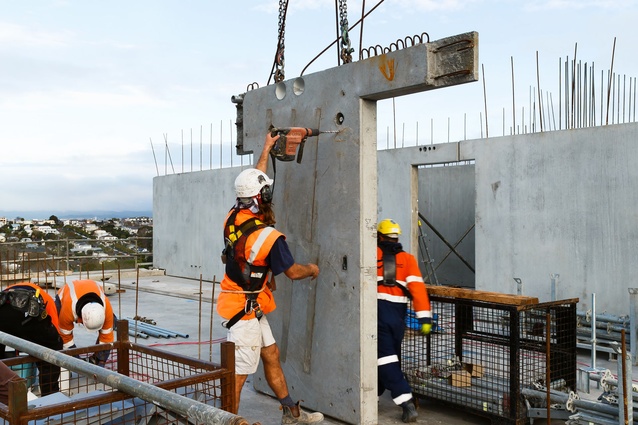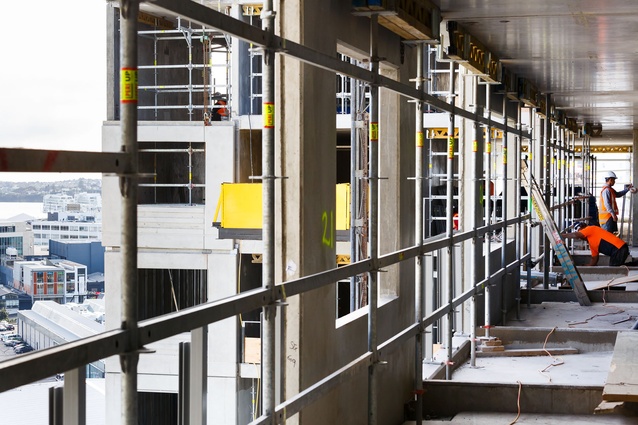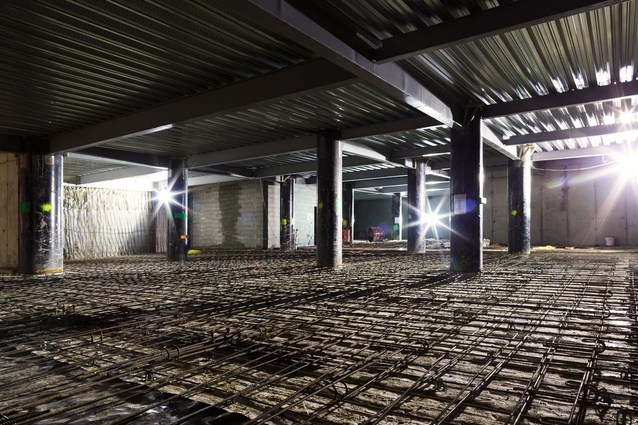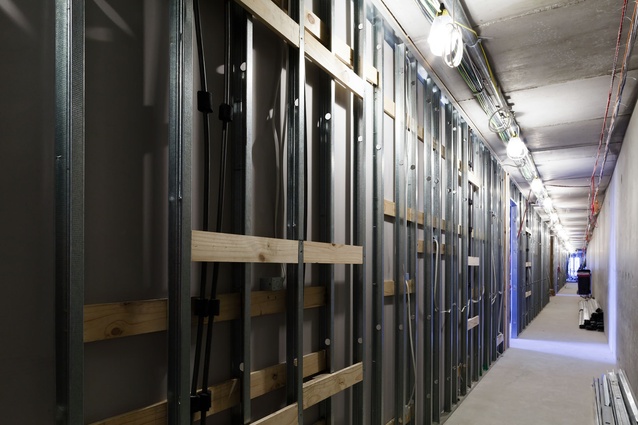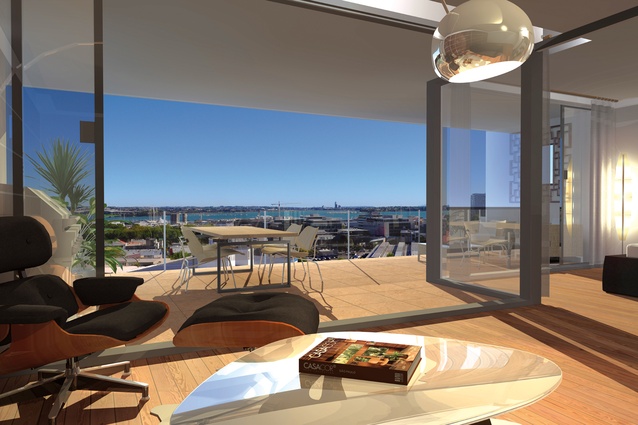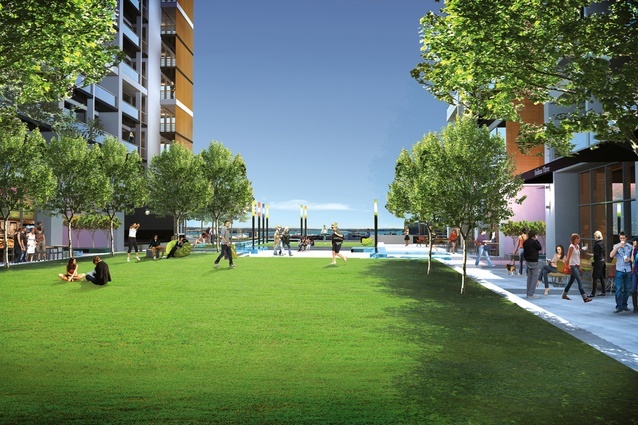The New Auckland: SugarTree development
In this series, The New Auckland, Progressive Building looks at some of the developments currently underway to house Auckland’s growing population. In this part, read about a $35 million apartment and retail complex in Auckland’s central business district, which is stage one of a three-stage development.
On an unusual 8,072m2 sloping site wedged between Nelson and Union streets in Auckland’s central business district, the country’s largest apartment complex is fast taking shape.
Prima, the $35 million project that is stage one of the SugarTree development, is scheduled for completion in early 2015: it will comprise 148 apartments of differing sizes over ten floors, as well as 15 ground-floor retail tenancies, and two sub-ground carpark levels.
Stage two of the development (Centro) kicked off at the end of September with the demolition of three buildings on the site, previously used by Kalmar Construction as a site office, and by developers Lily Nelson as offices. This stage will see construction of the largest of the three adjoining buildings – a $69 million edifice incorporating 220 apartments over 12 floors, and eight penthouse apartments on two additional top floors. Stage two will be completed in mid-2016; and stage three (Altro), incorporating a further 212 apartments, in 2017.
While some months lie between now and the overall completion of the development, stage one provides a fascinating glimpse into the design, engineering and construction of this mammoth project.
When Progressive Building visited the site in September, evidence pointing to the building’s unique construction methodology was still visible. At over 30 metres above ground, workers were completing the final structural stages of the ninth level of apartments, but below ground, the last area of the basement carpark was still being dug out.
Kalmar project manager Tim Ellery said by utilising the ‘top-down’ method, the construction schedule was able to be shortened by three months. “It was both a time and cost-driven solution,” he said. “It was an efficient way to build on this site to retain the neighbouring properties.
“With neighbouring buildings on both boundaries and the road frontage, it is an extremely tight site, so we used the top-down methodology to construct the basement carpark levels. This meant the piling along the boundary was completed before the first stage of excavation. Then the ground floor slab was constructed, allowing the commencement of the main building tower. Over the following months, the basement works progressed in several stages, from the front and out to the rear of the site, to form the two underground carpark levels.
“The main challenges centred around removing excavated material from these levels, given the limited height [with floors already built above], and constructing the shear walls to tie into the main structure above. For the first (front) half of the building, we were able to dig down the full two levels straight away and then put the intermediate level in after that. But on the other side of the building, we had to put the intermediate level in and then dig down after that.
“We used steel sleeves for the bored concrete piles because the carpark spaces are really tight. Utilising these meant we could use a laser to position the steel sleeves and then pour the concrete – and achieve a tolerance of under 20mm in the basement carparks. The sleeves are epoxy coated so as not to rust. Once we have dug out completely, all that needs to be done is a quick waterblast and two top coats of paint and you have a good looking basement column.”
Above ground, the largest tower crane in the country is kept busy lifting the hundreds of precast panels, balconies and floor slabs into place: it allows the team to install precast elements at a 50-metre radius. The largest of these precast panels weigh 13.5 tonnes and measures up to six metres in height.
Due to changed seismic requirements following the Canterbury earthquakes, much higher levels of reinforcing were required in the precast panel connections on the lower levels. For Ellery, even with his vast experience building skyscrapers, this was something he hadn’t come across before, and an issue that required considerable planning and forethought.
“This resulted in a double row of reinforcing bars in all shear walls. The standard drossbach connections couldn’t be used due to the limited space so we ended up using grout sleeves,” Ellery said. “These have a very small tolerance of only a few millimetres, and with two rows of bars at close centres, it was difficult to achieve the connection from level to level so we templated these panels after each floor slab pour to ensure the bars aligned with the next panel.”
While this took a considerable amount of time, the team see it as a learning experience for stage two, and plan to construct the lower walls in situ to ensure construction flows as efficiently as possible.
However, the high level of prefabrication involved in this project considerably reduced the work required on site: the entire structure is precast, including balconies, cladding panels, structural panels, stairs and flat slabs. “Because of the number of precast elements in the job, we had to let it out to four suppliers,” Ellery said.
Once completed, all three buildings will be linked via the ground floor podium and the two-level basement carpark, through which tenants will be able to drive the whole length of the three towers.
Stage one features a podium courtyard, which will incorporate two water features, decking, paving and soft landscaping. A striking glass-walled bridge will allow the level one corridor to run uninterrupted across the building.
During the peak of construction, up to 200 contractors were on site every day. This created one of the most significant challenges for the construction management team, Ellery said.
“With that amount of people and activity on site, a primary focus was about managinging workflow and resources. To ensure we had the right number of people on site at the right time, we dedicated a significant amount of time to communication and ensuring the subcontractors had the resources available. If they didn’t, we offered them help to find the resources they needed.”
For Ellery, who lives and breathes SugarTree at the moment, and will do for some years to come, he says while any project of this scale has its challenges, “it’s great to be involved”. And it’s clear, even without seeing the finished complex, why that is – this is a project that looks set to inject some much-needed vitality into Auckland’s rather lacklustre apartment market.
For more on The New Auckland, click here.

